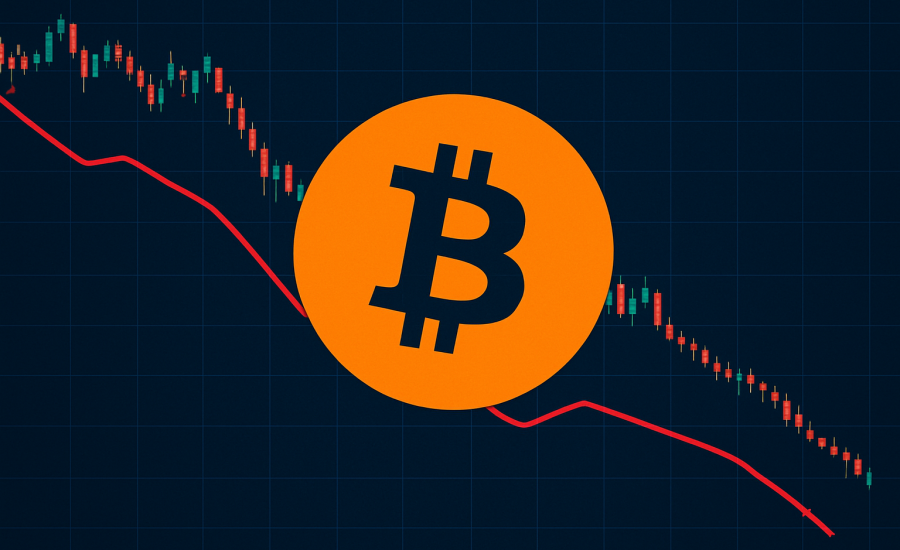Introduction
As the Asian markets opened, a wave of caution washed over both cryptocurrency and equity markets. The sharp movements reflected growing anxiety about the global macroeconomic landscape. Bitcoin dropped below the critical 100000 mark, signalling a shift in sentiment and raising new questions about the sustainability of the recent rally. This move did not occur in isolation. Across equities, commodities and other risk assets, the tone was similarly defensive as traders reacted to rising inflation pressures and a rapid unwinding of expectations for imminent interest rate cuts.
Crypto Market Overview A Day Of Broad Declines
The cryptocurrency market experienced a decisive pullback as Bitcoin fell below 100000. This symbolic level had been viewed by many analysts as a psychological anchor. Once it broke, selling pressure accelerated. The global crypto market capitalization contracted significantly, driven not only by Bitcoin but by steep declines in major altcoins as well. Ethereum, XRP and other high liquidity tokens all experienced meaningful losses as traders unwound positions.
An important factor behind the downturn was deteriorating liquidity in crypto markets. Market depth had thinned in recent sessions, making prices more sensitive to sell orders. Long term holders began realizing profits, and leveraged traders faced forced unwinds as funding rates shifted. The combination of soft liquidity and aggressive selling created a cascading effect. The market had been driven for weeks by optimism and momentum, but this shift made clear that the underlying structure was not yet stable enough to absorb such a shock.
The decline also coincided with a slowdown in institutional engagement. Large financial entities that had been accumulating Bitcoin through fund products and derivative strategies appeared to be scaling back. Net outflows from Bitcoin related investment vehicles over the prior days hinted that confidence was waning. Without steady institutional inflows, the market lost one of its most reliable sources of support.
Equity Markets Reflect Broader Risk Off Mood
The weakness in crypto aligned closely with a similar downturn in global equity markets. The major United States indices recorded broad declines led by the technology heavy Nasdaq Composite. Risk sensitive sectors saw sharper drops as investors reassessed valuations in light of shifting interest rate expectations. The Dow Jones Industrial Average and the S and P 500 also fell significantly, reinforcing the narrative that a broader market repricing was underway.
Asian markets mirrored these losses. Japanese equities pulled back sharply, and indices across Australia, South Korea and New Zealand opened lower. The sentiment was further dampened by softer than expected economic data from China. Reports on retail sales and industrial production missed forecasts, highlighting ongoing challenges for the worlds second largest economy. These data points reinforced the idea that global growth momentum remains uneven, contributing to the risk off mood.
Key Drivers Behind The Downturn
Changing Federal Reserve Expectations
One of the most important catalysts behind the selling pressure was a sudden reassessment of Federal Reserve policy expectations. For weeks, markets had been pricing in the possibility of rate cuts by the end of the year. However, renewed inflation concerns began to undermine this narrative. Central bank officials emphasised that inflation remained sticky and that policy easing was not imminent.
As expectations shifted, bond yields adjusted upward. Higher yields typically reduce the relative attractiveness of non yielding assets such as cryptocurrencies and high growth equities. When investors realized that interest rates might remain elevated longer than anticipated, a broad repositioning began. This repositioning affected almost every segment of the market, from bonds to stocks to digital assets.
Liquidity Tightening and Institutional Retreat
Cryptocurrency markets are particularly sensitive to liquidity dynamics. In recent weeks, liquidity conditions had begun to soften as trading volumes thinned and market makers reduced exposure. When Bitcoin broke below a key level, these conditions magnified the move. Thin order books meant that sell orders had a disproportionate impact.
Institutional flows which had supported the rally earlier in the quarter showed signs of weakening. Several consecutive sessions of net outflows from major crypto fund products reinforced the idea that large investors were stepping back. Institutions often act as stabilizing forces in the market, providing steady demand. Without them, price swings become more pronounced and market confidence weakens.
Macro Data Adds to Uncertainty
On the macroeconomic front, new data releases supported the market’s caution. China’s economic numbers revealed softer retail activity and sluggish industrial production. Given China’s influence on global trade and commodity demand, these figures created renewed concerns about global economic resilience.
Meanwhile, inflation data from various regions suggested that price pressures were not easing as quickly as anticipated. This combination of slow growth and persistent inflation created a challenging environment for risk assets. Markets that had previously relied on optimism and speculative flows now faced the hard reality of a less supportive macro backdrop.
Implications For The Crypto Market
Short Term Outlook Volatility Likely to Persist
The break below 100000 represents more than just a technical event for Bitcoin. In the short term, it signals potential for continued volatility. Traders will watch closely to see whether Bitcoin can reclaim this level or whether the breach triggers additional selling. Market participants remain cautious, and without renewed institutional support, an immediate rebound may be difficult to sustain.
Altcoins are likely to remain under pressure. Historically, they underperform during periods of heightened volatility and declining liquidity. Traders tend to consolidate capital into Bitcoin or move to stablecoins, leaving altcoins vulnerable to sharper drawdowns.
Medium to Long Term Perspective Structure Remains Intact
Despite the turbulence, many analysts believe that the long term structural outlook for cryptocurrencies remains unchanged. Adoption trends continue to grow. Institutional interest, though temporarily weaker, remains part of the broader trajectory. Technological innovation continues across sectors including decentralized finance, tokenization and blockchain infrastructure.
Corrections such as the current one may ultimately strengthen the market by resetting overextended valuations and removing excess leverage. Once macro conditions stabilize and liquidity improves, the market may find a more sustainable foundation for future gains.
Relationship with Traditional Markets Continues to Deepen
The events of the day emphasize how closely crypto now moves with traditional financial markets. Bitcoin is no longer an isolated asset class. It reacts to the same macroeconomic forces that influence equities, commodities and bonds. This correlation will likely intensify as the crypto sector matures and becomes more deeply intertwined with global capital flows.
What Investors Should Monitor?
Investors navigating the current environment should pay close attention to several key areas. Central bank policy remains the most influential driver. Statements from policymakers and changes in interest rate expectations can quickly shift market sentiment. Liquidity metrics within the crypto ecosystem are also crucial. Market depth, trading volumes and exchange flows offer clues about overall stability.
Institutional flows into crypto investment products should be monitored as well. Renewed net inflows would be an early signal of stabilizing confidence. Additionally, macroeconomic data releases related to inflation, employment and industrial activity will shape expectations around growth and policy.
Technical levels for Bitcoin will also play an important role. Support and resistance zones can guide near term trading behaviour. A decisive move back above 100000 could restore optimism, while further declines might fuel another wave of risk reduction.
Conclusion
The drop in Bitcoin below 100000 marks a significant moment for global markets. It reflects a recalibration driven by rising inflation concerns, shifting expectations for interest rate policy and thinning liquidity. While the correction may feel abrupt, it is part of a broader adjustment taking place across risk assets.
Crypto remains fundamentally driven by long term structural forces. Yet its short term price action is increasingly shaped by global macroeconomic conditions. The coming weeks will determine whether this downturn becomes a deeper consolidation or simply a temporary pause in a larger trend.



